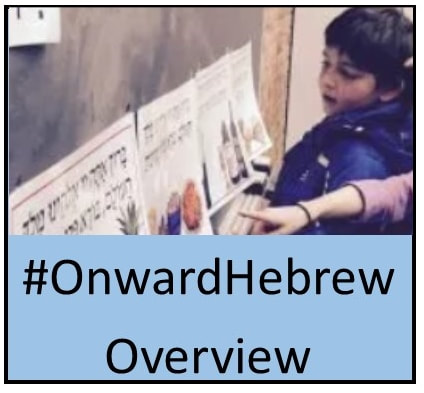|
#OnwardHebrew is changing the culture of Hebrew learning in part-time/congregational educational programs. Hebrew is no longer confined to 45-60 minute classes, but rather it moves (literally!) with Hebrew Through Movement, is brought into the minds and hearts of children via Hebrew-rich t'fillot/worship, and key Hebrew heritage words are infused regularly in English sentences. About half of the educational programs "in" with #OnwardHebrew teach decoding skills in fifth grade or later ... which means that about half teach them in third or fourth grade.
The four elements that make up the sound-to-print focus of #OnwardHebrew are:
Curious? Spend some time with this great overview webinar "#OnwardHebrew - For the Curious or Not Yet Convinced" AND/OR check the "Getting Started" brochure, linked below. |
Resources are linked to the photos and videos below. Click on what interests you!
START here:
|
ABOVE: The "GETTING STARTED" brochure offers short explanations of #OnwardHebrew and offers clues for integrating its elements into an educational program.
|
ABOVE: After you've read through the "Getting Started" brochure, spend some time with this curated list of resources that provides a good foundation for moving forward.
|
ABOVE: The links on this page will take you to the key resources that explain each element: HTM, JLV, t'fillah, decoding on a foundation of sound-to-print.
|
wHAT COLLEAGUES SAY:
|
ABOVE: What do education directors have to say about #OnwardHebrew? You are invited to peruse their sound-byte-size quotations.
|
ABOVE: Rabbi-Educator Nicki Greninger and Cantor Leigh Korn talk about #OnwardHebrew from each of their perspectives. Great conversation starter for synagogue leadership teams. (Webinar; 60 min)
|
ABOVE: Click on the icon for a playlist of the summer 2022 webinar series' video recordings on each of these topics: The Big Picture, HTM, JLV, T'fillah and Decoding
|
Great for STAKEHOLDER discussions :
|
ABOVE: The research on reading and the available learning time in part-time settings points to the need for big change in our programs. A great article to discuss with synagogue stakeholders.
|
ABOVE: Amazingly, not one #OnwardHebrew educational program looks exactly like the others. And that's okay - it's an initiative, a philosophy, not a specific curriculum.
|
ABOVE: The first half of this resource offers a variety of activities that are great for introducing #OnwardHebrew to various stakeholders - clergy, educators, parents, and committees. Adopt or adapt what fits your goals and culture. The second half of the booklet offers PD resources that support the introduction of and experimentation with research-based teaching strategies. For the latter, also check the "Conquering the Challenge of Decoding" webpage.
|
other resources:
Powered by the Jewish Education Center of Cleveland
www.jecc.org
www.jecc.org










